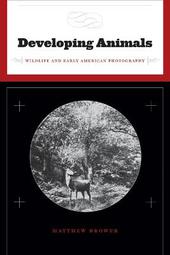
|
Developing Animals: Wildlife and Early American Photography
Paperback / softback
Main Details
| Title |
Developing Animals: Wildlife and Early American Photography
|
| Authors and Contributors |
By (author) Matthew Brower
|
| Physical Properties |
| Format:Paperback / softback | | Pages:256 | | Dimensions(mm): Height 229,Width 152 |
|
| Category/Genre | Animals and nature in art (still life, landscapes and seascapes, etc)
Photography and photographs |
|---|
| ISBN/Barcode |
9780816654796
|
| Classifications | Dewey:779.3209152 |
|---|
| Audience | | General | | Professional & Vocational | |
|---|
|
Publishing Details |
| Publisher |
University of Minnesota Press
|
| Imprint |
University of Minnesota Press
|
| Publication Date |
12 January 2011 |
| Publication Country |
United States
|
Description
Developing Animals compellingly investigates the way photography changed our perception of animals. Brower analyzes how photographers created new ideas about animals as they moved from taking pictures of taxidermic specimens in so-called natural settings to the emergence of practices such as camera hunting, which made it possible to capture images of creatures in the wild. He argues that photography has been essential to the conceptual separation of humans and animals.
Author Biography
Matthew Brower is curator of the University of Toronto Art Centre and a lecturer in museum studies in the Faculty of Information at the University of Toronto.
Reviews"In seeking to further our understanding of animal representations, Matthew Brower poses exactly the right question by asking not why we look at animals but how we look at them. Reframing the abundant and varied imagery of "animals in nature" in early American photography, he ably reveals how selective the rhetoric and vision of wildlife photography has now become. Developing Animals will have a real impact on contemporary debates about the representation of animals." -Steve Baker, author of Picturing the Beast "Matthew Brower's historical survey is a subtle and complex analysis of how wildlife photography, as a particular kind of contact between human and animal, has been central to our seeing and thinking about animals. This is an indispensable contribution to contemporary work on animals, vision, and the philosophy of animal representation." -Jonathan Burt, author of Animals in Film
|